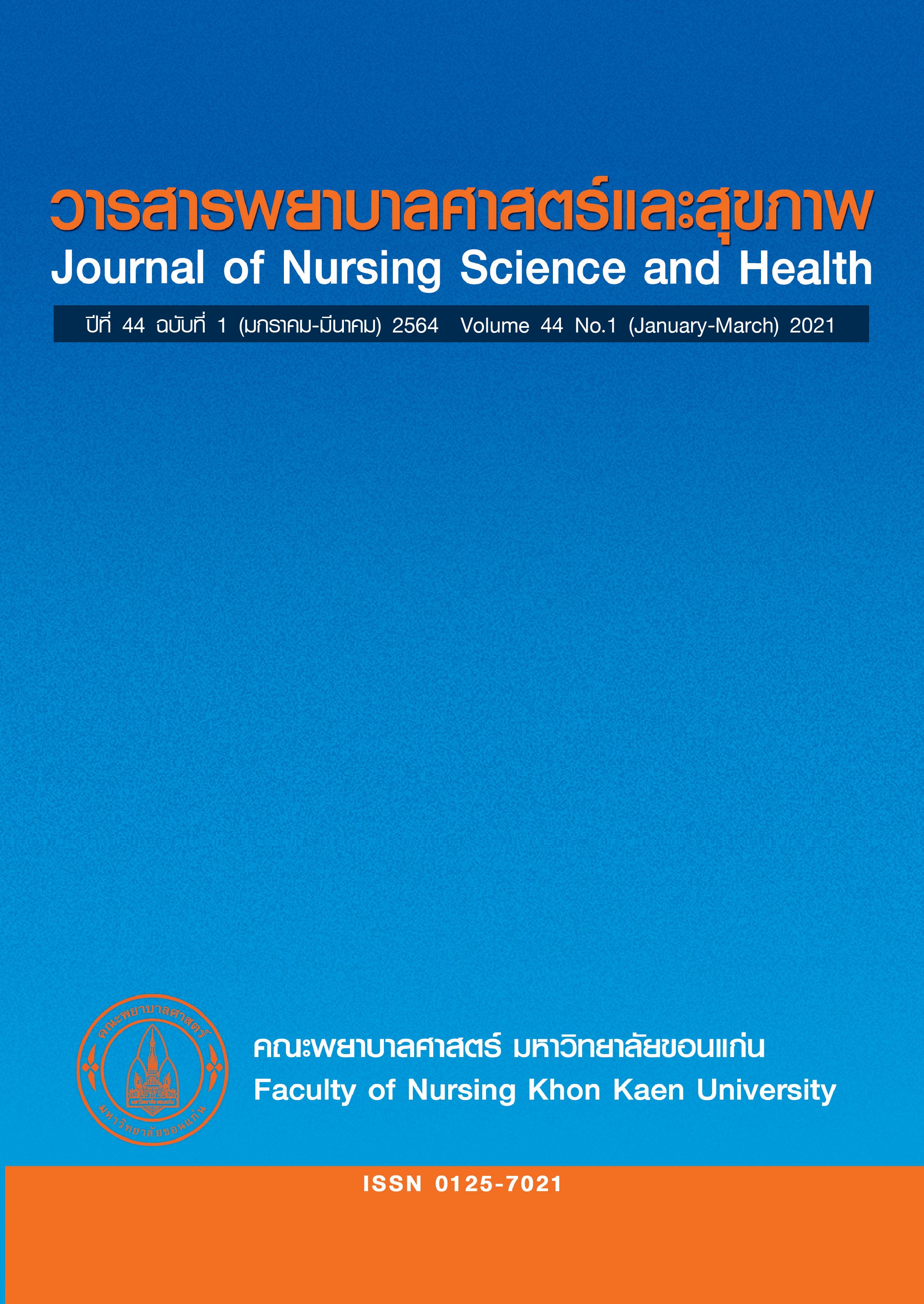ประสิทธิผลของโปรแกรมการสอนผ่านอุปกรณ์มือถือแบบพกพาต่อความรู้และการปฏิบัติของพยาบาลในการดูดเสมหะทางท่อช่วยหายใจ โรงพยาบาลศูนย์เว้ ประเทศเวียดนาม: การศึกษานำร่อง
คำสำคัญ:
การเรียนรู้ผ่านอุปกรณ์มือถือแบบพกพา, ความรู้, การปฏิบัติ, การดูดเสมหะทางท่อช่วยหายใจบทคัดย่อ
การทดลองแบบสุ่มและมีกลุ่มควบคุมนี้มีวัตถุประสงค์เพื่อประเมินประสิทธิผลของโปรแกรมการเรียนรู้ผ่านอุปกรณ์มือถือแบบพกพาต่อความรู้และการปฏิบัติของพยาบาลในการดูดเสมหะทางท่อช่วยหายใจ โดยสุ่มกลุ่มตัวอย่างที่เป็นพยาบาลปฏิบัติงานอยู่ในหออภิบาล 3 แห่ง ในโรงพยาบาลศูนย์เว้ ประเทศเวียดนาม จำนวน 30 คน และสุ่มแบ่งกลุ่มตัวอย่างออกเป็นกลุ่มทดลองและกลุ่มควบคุม โดยกลุ่มทดลองได้รับการสอนผ่านโปรแกรมที่ผู้วิจัยสร้างขึ้นตามแนวปฏิบัติการดูดเสมหะของโรงพยาบาลศูนย์เว้ นำเสนอเนื้อหาผ่านตัวอักษร ภาพ และวิดีโออุปกรณ์มือถือแบบพกพา ใช้เวลาประมาณ 30 นาที ส่วนกลุ่มควบคุมได้รับการสอนตามปกติของโรงพยาบาล ใช้เวลาในการทดลอง 1 เดือน และวัดผลก่อน-หลังการทดลอง เครื่องมือที่ใช้เก็บข้อมูล ได้แก่ แบบประเมินความรู้ในการดูดเสหะจำนวน 15 ข้อ และแบบตรวจสอบการปฏิบัติการดูดเสมหะจำนวน 16 หัวข้อ (21 ขั้นตอน) วิเคราะห์ข้อมูลด้วยสถิติเชิงบรรยาย ได้แก่ ความถี่ ร้อยละ ค่าเฉลี่ย ส่วนเบี่ยงเบนมาตรฐาน Chi-square test, Fisher’s exact test และ independent t-test ผลการวิจัยพบว่า หลังการทดลองกลุ่มทดลองมีค่าเฉลี่ยคะแนนความรู้และปฏิบัติสูงกว่ากลุ่มควบคุมอย่างมีนัยสำคัญทางสถิติ (p<0.001) และกลุ่มทดลองมีค่าคะแนนเฉลี่ยความรู้และปฏิบัติหลังการทดลองสูงกว่าก่อนทดลองอย่างมีนัยสำคัญทางสถิติที่ (p<0.001) ซึ่งแสดงให้เห็นว่าโปรแกรมการเรียนรู้ผ่านอุปกรณ์มือถือแบบพกพานี้สามารถช่วยพัฒนาความรู้และการปฏิบัติการดูดเสมหะทางท่อช่วยหายใจของพยาบาลได้ และเห็นควรที่จะนำโปรแกรมนี้ไปใช้จริงในหออภิบาลเพื่อเพิ่มประสิทธิภาพในการดูแลผู้ป่วยที่ใส่ท่อช่วยหายใจให้ดียิ่งขึ้น
เอกสารอ้างอิง
Negro A, Ranzani R, Villa M, Manara D. Survey of Italian intensive care unit nurses’ knowledge about endotracheal suctioning guidelines. Intensive and Critical Care Nursing 2020;30(6):339–45.
AARCClinicalpracticeguidelines.Endotracheal suctioning of mechanically ventilated patients with artificial airways 2010. Respiratory Care 2010; 55(6): 758-64. Available from: https://pubmed.ncbi.nlm.nih.gov/ 20507660/.
Çelik SS, Elbas NÖ. The standard of suction forpatientsundergoingendotracheal intubation. Intensive Critical Care Nursing 2000;16(3):191–8. Available from: https://linkinghub.elsevier.com/retrieve/ pii/S0964339700914873.
Day T, Farnell S, Haynes S, Wainwright S, Wilson-Barnett J. Tracheal suctioning: An exploration of nurses’ knowledge and competence in acute and high dependency ward areas. Journal of Advance Nursing 2002;39(1):35–45. Available from: http://doi.wiley.com/10.1046/j.1365- 2648.2002.02240.x.
Hue Central Hospital. Endotracheal suctioning protocol;2019.
Majeed HM. Assessment of knowledge and practices of intensive care unit nurses about endotracheal suctioning for adult patients in Baghdad teaching hospitals, Iraq. International Journal of Research in Medical Sciences 2017;5(4):1396-404. Available from: https://www.researchgate.net/ publication/315989847.
Ortega LDM, Plata RB, Jiménez Rodríguez ML, Hilera González JR, Martínez Herráiz JJ, Gutiérrez De Mesa JA. Using M-learning on nursing courses to improve learning. Computers, Informatics, Nursing 2011;29(5):311–7. Available from: http:// journals.lww.com/00024665-201105000- 00008.
Halita JP, Fatima DS, Thankappan SS. Knowledge and practices of endotracheal suctioning among nursing professionals: A systematic review. Indian Journal of Critical Care Medicine 2020;24(1):23-32. Available from: https://pubmed.ncbi.nlm.nih. gov/32148345/.
RachmawatiK,SchultzT,CusackL.Translation, adaptationandpsychometrictestingofatool for measuring nurses’ attitudes towards research in Indonesian primary health care. Nursing Open 2017;4(2):96-100. Available from:https:// onlinelibrary.wiley.com/doi/epdf/10.1002/ nop2.72.
Sole ML, Byers JF, Ludy JE, Zhang Y, Banta CM, Brummel K. A multisite survey of suctioning techniques and airway management practices. American Journal of Critical Care 2003;12(3):220-30.Availablefrom:https:// pubmed.ncbi.nlm.nih.gov/12751396/.
Lee SG, Shin YH. Effects of self-directed feedback practice using smartphone videos on basic nursing skills, confidence in performance and learning satisfaction. Journal of KoreanAcademyofNursing 2016;46(2):283. Available from: https://pubmed.ncbi.nih. gov/27182024/.
Seema S, Pity K, Kiran B. Effectiveness of suction protocol on nurse’s and patient’s outcome in ICU. Asian Journal of Nursing Education and Research 2017;7(4):589. Available from:http://www.indianjournals.com/ijor.aspx?target=ijor:ajner& volume=7&issue=4&article=02.
Mwakanyanga ET, Masika GM, Tarimo EAM. Intensive care nurses’ knowledge and practice on endotracheal suctioning of the intubated patient: A quantitative cross-sectional observational study.PLOS ONE 2020;13(8): 1-13. Available from:https://www.ncbi.nlm. nih.gov/pmc/articles/PMC6095500.
Aboalizm SE, Abd Elhy AH. Effect of educational intervention on nurses’ knowledge and practices regarding endotracheal tube suctioning. International Journalof Nursingand Health Science 2019;5(3):1-8. Available from:http://www. internationaljournalssrg.org/ IJNHS/paper-details?Id=31.
Kargar M, Shirazi ZH, Edraki M, Pishva N, Ghaem H, Chohedri AH, et al. The effects of ETT suction education on the knowledge and performance of intensive care nurses. Anesthesia,Pain & Intensive Care 2008;12(1):5-10. Availablefrom:https://applications.emro.who. int/imemrf/.
ดาวน์โหลด
เผยแพร่แล้ว
รูปแบบการอ้างอิง
ฉบับ
ประเภทบทความ
สัญญาอนุญาต
วารสารพยาบาลศาสตร์และสุขภาพเป็นเจ้าของลิขสิทธิ์ในการเผยแพร่ผลงานที่ตีพิมพ์ห้ามผู้ใดนำบทความที่ได้รับการตีพิมพ์ในวารสารพยาบาลศาสตร์และสุขภาพไปเผยแพร่ในลักษณะต่าง ๆ ดังนี้ การนำบทความไปเผยแพร่ออนไลน์ การถ่ายเอกสารบทความเพื่อกิจกรรมที่ไม่ใช่การเรียนการสอน การส่งบทความไปตีพิมพ์เผยแพร่ที่อื่น ยกเว้นเสียแต่ได้รับอนุญาตจากวารสารพยาบาลศาสตร์และสุขภาพ



